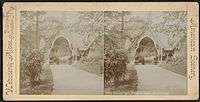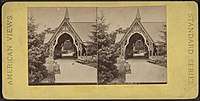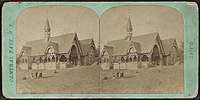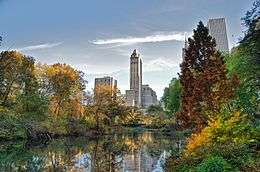The Dairy
The Dairy is a small building in Central Park in Manhattan, New York City, just south of the 65th Street transverse road. The building was designed by the architect Calvert Vaux, and was completed in 1871 as a restaurant. After a restoration, it serves as one of several visitor centers in Central Park.[1]
Location
The Dairy is located on the southern side of Central Park just south of the 65th Street transverse road. Adjacent features include the Central Park Carousel and the Heckscher Playground and Ballfields to the west, Sheep Meadow to the northwest, Central Park Mall to the north, Central Park Zoo to the east, The Pond and Hallett Nature Sanctuary to the southeast, and Wollman Rink to the south.[2]
History
The Dairy was included in the Greensward Plan, the original plan for the construction of Central Park.[3]:38–39 Construction began in September 1869.[3]:74[4]:535 In a progress report written by Olmsted Vaux & Co. to the Department of Public Parks, dated June 6, 1870, the architects stated, "The Dairy [is] a stone structure, the cellar of which connects directly with one of the traffic roads, it being the intention that the building should receive its main supplies from the exterior of the park. The Dairy is intended to serve as a refreshment room for adult visitors, and for the furnishing of supplies to parties of children who will congregate in the rustic shelter and in the play-grounds. The completion of this building, as designed in accordance with an estimate prepared in conjunction with the Architect-in-chief, will cost $3,000."[4]:477–478
The Dairy was incorporated into the Children's District, which was not part of the initial plans for Central Park.[4]:477–478[5] The district also included Playmates Arch, Heckscher Playground and Ballfields, the Chess & Checkers House, the now-demolished Children's Cottage, and the Central Park Carousel.[5][6] As originally planned, the Dairy would be used as a place to buy milk and other small snacks, as well as borrow board games.[3]:46[6] The cows that provided the milk would be housed in the cottage's basement.[7] However, after an incident regarding the sale of tainted milk, more stringent regulations were instituted in the 1860s. The game loans ultimately became the purview of the Children's Cottage.[5]
On the southern facade, a loggia or covered porch allowed visitors to enjoy the nearby Pond; the portion of the pond facing the Dairy is now occupied by Wollman Rink.[3]:38[6] The building also contains several Gothic Revival elements including a great hall with large church-like windows, a spire, and a roof with a steep pitch.[5]
Decline
The Dairy was completed in 1871, and following political pressure from legislator William Tweed, was used as a restaurant.[5] In 1921, the restaurant operator Eugene Glenn paid an annual fee of $12,250 for the franchise. In the 1930s, Park Commissioner Robert Moses converted it to a storage facility, and by 1950, the building was in decline. That year, a reporter for The New York Times wrote that, "untrimmed tree branches jut into its shingled roof," and "leader pipes have long since separated from the gutters and sag uselessly."[8] The loggia of the Dairy was demolished in 1955. The building was later closed altogether due to the New York City fiscal crisis of the 1970s.[9] In the interim, it was used as a maintenance shed.[5]
Restoration
In 1979, the architects Weisberg, Castro Associates, following designs prepared in 1978 by the architect James R. Lamantia (1923–2011), restored the northern half of the structure, a renovation undertaken by the Central Park Community Fund and financed in part by Revlon, Inc. The renovated building reopened on November 17, 1979.[9] In 1981, the newly formed Central Park Conservancy rebuilt the loggia that had been demolished in 1955.[10] The loggia was designed by James R. Lamantia and the firm of Russo + Sonder.[11]
In 2016, the Conservancy started raising funds for the restoration of several structures in Central Park, including the Dairy.[12] The building serves as one of the five Conservancy's visitor centers and also contains a gift shop.[1]
Gallery
_(18245999008).jpg) The Architect's sketch published in 1869.
The Architect's sketch published in 1869. A stereoscope view of the Dairy (after 1870).
A stereoscope view of the Dairy (after 1870). A stereoscope view of the Dairy (after 1870).
A stereoscope view of the Dairy (after 1870). A stereoscope view of the Dairy (after 1870).
A stereoscope view of the Dairy (after 1870).- The Dairy in 2010.
References
- Central Park Conservancy. "Dairy Visitor Center & Gift Shop". www.centralparknyc.org. Retrieved September 11, 2019.
- "Central Park Map" (PDF). centralparknyc.org. Central Park Conservancy. 2014. Retrieved April 1, 2019.
- Kinkead, Eugene (1990). Central Park, 1857-1995: The Birth, Decline, and Renewal of a National Treasure. New York: Norton. ISBN 0-393-02531-4.
- Olmsted, Frederick Law, ed. (1922). Frederick Law Olmsted, Landscape Architect, 1822-1903. Frederick Law Olmsted, Landscape Architect, 1822-1903. G.P. Putnam's Sons. Retrieved September 10, 2019.
- "Central Park Highlights - The Dairy : NYC Parks". www.nycgovparks.org. Retrieved September 10, 2019.
- Central Park Conservancy. "The Children's District: Then and Now". www.centralparknyc.org. Retrieved September 10, 2019.
- "Central Park Dairy". The New York Times. February 18, 1970. Retrieved September 11, 2019.
- Johnston, Richard J.H. (May 17, 1950). "Stroll Confirms Neglect Of Park; Evidences Of Disrepair That Can Be Found In Central Park". The New York Times. Retrieved September 10, 2019.
- Goldberger, Paul (November 16, 1979). "1870 Dairy In the Park Reopening; Victim of Fiscal Crisis". The New York Times. Retrieved September 10, 2019.
- Carmody, Deirdre (October 15, 1981). "Victorian Dairy Opens Once More In The Park". The New York Times. Retrieved September 10, 2019.
- Drawings for restoration of Dairy Barn, Phase II, Central Park. James R. Lamantia and Russo & Sonders architects. 1980. 15 sheets.
- "Central Park, Bucolic but Aging, Is in a Quest for $300 Million". The New York Times. July 14, 2016. Retrieved September 10, 2019.
External links
| Wikimedia Commons has media related to Dairy in Central Park. |


.jpg)